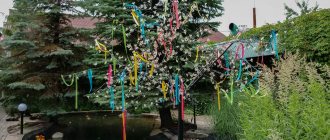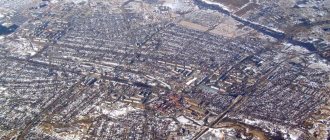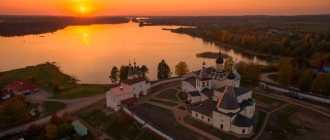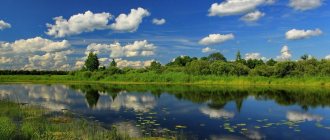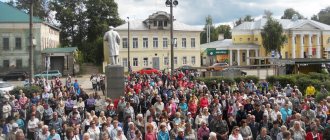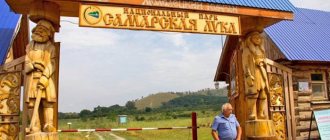The expanses of the Russian Federation are a treasure trove of beautiful places, preserved and protected since ancient times or created more recently. Each of them is famous for some of its own characteristics: traditions, history, great people. In all regions there are large and small towns with museums, cultural monuments, nature reserves and other objects of interest to both tourists and ordinary vacationers. Here you can expand your horizons, learn a lot of new interesting information, and simply enjoy the magnificent scenery.
Ivanovo region
Its territory is one of the smallest in Russia. It was formed relatively recently by historical standards, and occupies the area of the former Vladimir and Kostroma provinces. Most of the land is located under the Gorky Sea, a reservoir formed from the construction of the Nizhny Novgorod hydroelectric power station. The shores and islands of this man-made reservoir are a favorite vacation spot for indigenous residents and guests of the region. Ivanovo textile enterprises with their products are known to everyone; they have become the calling card of the region. Light industry began its development from here, and today the life of the city is also associated with the work of spinning and manufacturing factories and combines. The industrial history of the region is clearly presented in the museums of Ivanovo chintz, as well as industry and art.
Not only industry developed in this region. The revolutionary spirit of the workers also grew. The turn of the century was marked by large-scale uprisings, which were brutally suppressed by the Cossacks. Descendants are reminded of those events by the erected memorial complex, called “Red Talka”, and the factory-kitchen, which tells about the dreams of workers about a new life. Now it houses a museum and a library. The oldest cities in the Ivanovo region are Yuryevets, miraculously preserved after the flooding of the reservoir, and Ples, modestly located on the high bank of the Volga. The first was the childhood home of directors Arthur Rowe and Andrei Tarkovsky, the second was made famous by Isaac Levitan, depicting it on his canvases. Folk crafts have long flourished in these places; the main fishing centers were the famous villages of Kholui and Palekh. The first keeps the secrets of the local school of icon painting, and the second has been painting lacquer boxes and souvenir crafts for hundreds of years.
Natural attractions in the vicinity of Yuryevets
The flora and fauna of the Yuryevets district deserve special attention; some natural monuments are unique.
"Nagornaya Dacha"
- GPS coordinates: 57.315540, 43.073549.
Yuryevets is located in a surprisingly picturesque place: the city stands on high hills, a sea-like reservoir splashes in the east, and a forest rustles on the western side. The dense coniferous forest was named “Nagornaya Dacha” and has the status of a natural monument.
The total area of the protected area is 635 hectares. Most of the trees in Dacha are pine and spruce; the age of some specimens has crossed the hundred-year mark, and some centenarians are approaching their 200th anniversary.
In addition to them, there are cedars, oaks, larches, aspens, maples, lindens, poplars and other trees on the territory. The forest is home to many wild animals, birds and insects, and dozens of species of mushrooms, berries and medicinal herbs grow.
Mount Asaph
- Coordinates: 57.290816, 43.159576.
The natural monument, also called Osapovy Gory, is located near the city in the middle of the Gorky Reservoir. Seeing five pieces of land jutting out of the water, visitors to the area wonder: why are they called mountains? These are islands! Paradoxically, the mountains of Asaph really are mountains, or, more precisely, they were.
The hills reached tens of meters above the ground until the reservoir was created. The Volga flooded the land around the mountains, leaving only the forested tops sticking out of the water.
The resulting islands became a nesting center for waterfowl and a popular vacation spot among area residents and visitors from other regions. There are also small fish-rich lakes here. Tourists come to the Asaph Mountains to swim, sunbathe on sandy beaches, enjoy the scent of pine trees and go fishing.
Key of Simon the Blessed
- Coordinates: 57.349551, 42.772414.
Blessed Simon Yurievetsky lived back in the 16th century. In his youth, Simon left his parents' home, choosing the path of foolishness for Christ's sake. One day, the local governor Fyodor Petelin was angry with the holy fool and ordered his servants to beat him. It is believed that the servants overtook the saint near the village of Mikhailovka near a spring that he himself had dug. Simon could not stand the torture and died.
Even during his lifetime, the Holy Fool was considered a saint, so the place of his death began to be revered as a shrine. Several years ago, the inhabitants of the Nikolo-Shartom monastery erected a cross here and equipped a holy spring. A bathhouse and a wooden chapel were built above the spring, and a covered plank bridge leads to the church. Pilgrims from different regions of the country come to the spring of St. Simon.
Story
Yuryevets is one of the oldest cities, founded by Yuri II, Prince of Vladimir, in 1225 as a fortification. Here the icon of St. George the Victorious appeared to him, in whose honor the city was given the name Yuriev-Povolsky. 12 years later it was destroyed by Batu’s army. Initially, it was a defensive fortress protecting Central and Northern Rus' from eastern raids, which over time turned into an important trade hub. In the mid-twentieth century, during the construction of the Gorky Reservoir, the city was expected to be completely flooded, but it survived, while nearby villages with churches and other buildings were under water. The fates of the film storyteller A. Rowe and the cult director A. Tarkovsky are connected with these places. One of the streets is named after the latter, and the house where he grew up has been turned into a museum. Both of these people spent their childhood here.
Museums of public education, historical and artistic exhibits and soft toys (located in the neighboring village of Kostyaeva), many other places should definitely be visited when arriving in Yuryevets, Ivanovo region. Your vacation will be complete if you also visit the Gorky Reservoir.
Volga from source to mouth. Yuryevets.
Yuryevets has a long and glorious history. It was founded at the confluence of three rivers - the Volga, Unzha and Nemda.
According to the most common version, the city was founded by the Vladimir prince Yuri (George) Vsevolodich as Yuryev-Povolsky and named after him (another name is Georgievsk).
According to legend, the Grand Duke of Vladimir Yuri Vsevolodovich, son of Vsevolod the Big Nest, returning from his nephews, the sons of his late brother Konstantin, stopped to rest at the mouth of the Unzha River, the left tributary of the Volga.
While sleeping, he had a vision: on the opposite bank, among an impenetrable thicket, there was a mountain, and on it was an icon of St. George the Victorious, in front of which a candle was burning. Having woken up, the Grand Duke ordered to go down the Volga and, approaching the creek, now called Yuryeva, he began to carefully look at the other bank of the Volga. The prince suddenly saw a fiery ray like a shining star breaking through from an unknown mountain, through the thicket of the forest. The prince with his boyar Vasily, nicknamed Skorumny, and his retinue crossed to the right bank of the Volga. There, in a dark forest, on a steep mountain, he allegedly found a miraculous icon, in front of which a candle burned in a dream. In memory of the event, the mountain began to be called St. George, and the icon, according to the chronicle, written on a board with spherical outlines, was subsequently transferred to the Moscow Assumption Cathedral.
Another legend says that the icon was carved on stone. At the site where the icon was found, the prince ordered the construction of a wooden city, calling it by his name and in honor of the saint of God Georgievsky or Yuryev-Povolsky (Povolzhsky).
According to the second version, the city was founded by Prince Yuri in 1150. In the “Selected Works” of V. N. Tatishchev, where his notes were first published during the preparation of “Russian History”, in many chronicles and documents that have not reached us, it is stated that “a town on the Volga in White Rus' is also named Yuryev, built by Yury or George II in 1150, now called Yuryev Povolsky, or Yuryevets, which is in the province of Nizhny Novgorod on the right bank of the river above Bolokhny 90 and below Kineshma 60 versts.”
The first Yuryevets fortress stood on St. George's Mountain. High walls were erected on earthen ramparts surrounded by ditches. All that is known about the fortress is that it was originally built of wood. It becomes clear that the fortress was often destroyed in fires, although each time after them it was restored in its place. In the 17th century, when the city was devastated by the army of Pan Lisovsky, the “White City” was built not in its place, but on the nearby Simonovskaya Mountain.
Yurievetsky Zemlyanye Vals
Unfortunately, it has not survived to this day - it was demolished for the construction of a protective dam on the banks of the Volga. Now in Yuryevets you can see the preserved ramparts and ditches of his last fortress - the White City.
The White City is considered one of the rare monuments of Russian military engineering art.
Yurievetsky Posad was located under the mountain, on the banks of the Volga. It occupied the territory that is now located between the river port and the former post office building. It was surrounded on all sides by monasteries, which, along with fortresses, were part of the defense system of the ancient city.
In 1237, Yuryevets was burned by the hordes of Batu. This past left its mark on the etymology of many city names. Gunners lived on Mount Pushkarikhe, and from the high Glazovaya Mountain they “looked” to see if the Tatars were coming from the lower reaches of the Volga.
In 1380, Yuryevets warriors fought bravely on the Kulikovo field in the regiments of their prince Vladimir Andreevich Gorodetsky-Serpukhovsky, cousin of Dmitry Donskoy. Since 1405, Yuryevets was part of the Gorodets principality, from 1448 - the Moscow principality, and from 1451 - the Suzdal principality, then again - the Moscow principality. In 1536-1537 the city was plundered by the Kazan Tatars. And in 1556 he was discharged by Ivan IV to the oprichnina.
At the beginning of the 17th century, during the period of the Polish-Lithuanian intervention, Yuryevets was repeatedly attacked by the Poles. In 1609, the local centurion Fyodor the Red led the local militia, which liberated Lukh, Shuya, and Kineshma. In response, the famous Pan Lisovsky burned the city, but the residents of the surrounding area bravely fought off his fighters, and help that came to them from Nizhny Novgorod along the Volga saved the situation. The townspeople joined the troops of Pozharsky and Minin passing through the city, but the liberation of Moscow in 1612 did not bring the desired stability. In 1614, the Cossacks of Ivan Zarutsky again plundered and burned Yuryevets, although they were later defeated by the governor Boris Lykov.
At the end of the 18th century, Yuryevets became a district town in the Kostroma province. Free by nature, Yuryevites engage in seasonal work: they go to barge haulers, rafting and sawing timber. Yuryevets becomes one of the barge hauler centers on the Volga with its “Fried Hillock” - the place for traditional rites of initiation into barge haulers. The Volga connects all of Russia, from the Baltic to the Caspian. Up the Unzha from Yuryevets the ancient path “beyond the Stone” began - to the Urals and beyond. Yuryev local historians are confident that Ermak Timofeevich is their fellow countryman. His grandfather, an old robber, was allegedly hiding from detectives in Yuryevets, and after his grandfather’s death, his grandson set off to conquer Siberia.
In the era of Peter I, when the administrative division of the country into provinces was introduced, Yuryevets became part of the Kazan province from 1708.
City status since 1778. For the city's services to the country, on March 29, 1779, Catherine II granted Yuryevets a personalized coat of arms: despite the fact that it is not a provincial center, the heraldic shield contains only the symbol of the city, without the provincial coat of arms.
The coat of arms of Yuryevets is a silver watchtower on a blue field. In some images of the coat of arms, instead of an abstract tower, a local landmark is drawn - a five-tiered bell tower.
At the turn of the 19th and 20th centuries, Yuryevets was not much different from other provincial Russian cities. Some of the crafts and trades of Yuryev residents have traditionally been associated with the Volga. The port city owes its worthy reputation to the skill and hard work of river workers, shipbuilders, fish catchers, and carriers.
Already in 1795 the city had a regular layout with a main square. The mayor's house, city administration, treasury, and Epiphany Church of the early 18th century were built; later, in the very center - the ensemble of the old (1806) and new (1825-1833) Cathedrals of the Entrance to Jerusalem, the Church of the Nativity (1815).
Assumption and Entrance to Jerusalem Cathedrals
The main architectural complex of the city is located at the intersection of the main street and the shopping area - the Assumption and Entrance of Jerusalem Cathedrals with a bell tower. The ensemble of cathedrals was erected in 1733 and rebuilt in 1806 by the provincial architect N.I. Metlin.
Bell tower of the Cathedral of the Entrance to Jerusalem in Yuryevets
In the central part of Yuryevets there is a remarkable Church of the Nativity of Christ, which faces the main street with its facade. The construction of the church took place in 1815, but already in the middle of the 19th century
The Church of the Epiphany, which is the oldest building of the surviving architectural monuments.
In the Temple are the relics of Blessed Simon Yurievetsky, the Fool for Christ's sake.
Church of the Holy Spirit
It was built in the middle of the cemetery in the first half of the 19th century at the expense of the merchant Ivan Polyakov. Services in the church were conducted even during the times of militant atheism, without interruption during the twentieth century.
Sretenskaya Church
Monastery church, which was erected on the banks of the Volga. In the 20th century, the church bell tower was destroyed, and the temple premises were given over to a brewery warehouse. Today the temple is gradually being restored.
In Yuryevets you often come across the name of Tarkovsky
Andrei Tarkovsky Museum Center
The museum is opened in the house where the Tarkovsky family lived.
Cultural Center named after A.A. Tarkovsky
This is a modern cinema center. It hosts a film school and hosts creative meetings and festivals.
The building was built in 1903. During the war there was an elementary school here, where Tarkovsky studied.
Streets and buildings
Vesnin Museum
The museum was opened in 1980 in the Vesnins’ family nest. Paintings, documents and photographs from personal archives, projects of three famous architect brothers of the 1920s are stored here.
Cherkassky House
Mikhail Nikolaevich Cherkassky was a zemstvo construction technician. Under his leadership, many buildings were built in the city. He remodeled an existing building for his family. The Cherkassky family nest is a residential building with a mezzanine. Its appearance has classical features, elements of folk architecture and Art Nouveau style. The building is decorated with wood carvings. The mansion adorns the main street of Yuryevets; now it houses a local history museum.
Theater-Museum "Istoki"
This is a kind of museum of dolls and unusual arts. The dolls are made in the shape of literary characters. It is here that you can see familiar images performed by local craftsmen using folk techniques.
And of course, Volga
A 12-meter-high worship Cross 2 kilometers from the shore commemorates the Krivozersky monastery hidden by the Volga waters, which fell into the flood zone. The monastery was preserved only in Levitan’s paintings, the famous “Evening Bells” and “Quiet Abode”
Painting Quiet Abode
Isaac Levitan "Evening Bells".
And where would we be without this beauty...
GOOD LUCK !!!
Ecological state
Yuryevets, Ivanovo region, is characterized not only by very picturesque landscapes, but also by a prosperous natural environment. This is one of the cleanest areas in the central part of Russia; the radioactive background here is the least. Yuryevets, Ivanovo region, is surrounded by a protected area with pine forests and birch forests. They are rich in berries and mushrooms. Many compatriots from nearby regions travel to Yuryevets, Ivanovo region, in the summer. The fishing here is excellent and the rivers are teeming with fish.
Gorky Reservoir
In fact, the man-made reservoir occupies the territories of 4 regions: Nizhny Novgorod, Yaroslavl, Kostroma, and Ivanovo. However, the most picturesque places are considered to be the last one. They are located near Ples and Yuryevets. Here, nearby, are the Asaph Islands, which were mountains until the mid-twentieth century. They remained on the surface of the water after the surrounding area was flooded, and today 5 areas of land with small lakes and sandy shores have become especially popular among swimmers and fishermen. This is almost a tropical corner, only the vegetation is represented not by palm trees, but by pine trees. You can get here by boat; the distance between the banks is only 3 km. The swimming season is an ideal time to relax on the islands, especially with tents.
Plyos
For most visitors to the town, even if they have never been here, many places seem familiar.
This is due to the preserved image of the ideal province - prosperous, cozy, clean, modest. Therefore, films have been shot here many times. On the territory of the city there are a large number of small museums exhibiting exhibits from the life of an ancient Russian family, weddings, primitive hunting and fishing. They are interesting for both adults and children, because pictures of the everyday life of their ancestors come to life before their eyes, which is much easier to perceive than the abundance of “dry” dates and historical events. A very interesting art gallery with Levitan's works exhibited in rooms once rented by the artist. Many works in his creative life are associated with Ples; this period became one of the most productive. The painter, as a true connoisseur of Russian nature, highlighted these places for a reason. Everything here is impressive: the water surface of the Volga, the quiet evenings, and the birch groves. And the main value of these landscapes is their pristineness: even today there are no industrial enterprises in the city. Another characteristic local feature is the tradition of setting full tables, as in the times of merchants, with fish soup, pies, pies and fish. However, you quickly work up an appetite after long walks along the embankment. And from December to March, a ski recreation center with a cross-country route and two “Sweet Mountain” trails is open here, which additionally attracts visitors.
White City
The White City was located on a mountain overlooking the river port. This is one of the most picturesque corners of Yuryevets with mighty pine trees and quiet ponds. The White City is considered one of the rare monuments of Russian military engineering art. Behind its walls, under the mountain, on the banks of the Volga, there was a settlement. It occupied the area that is now located between the port and the former post office building. It was surrounded on all sides by monasteries, which together with the fortress were part of the city’s defense system.
In 1237, Yuryevets was burned by the hordes of Batu. This past is reflected in many city names. Gunners lived on Mount Pushkarikhe, and from the high Glazovaya Mountain they “looked” to see if the Tatars were coming from the lower reaches of the Volga. In 1380, Yuryevets warriors fought on the Kulikovo field in the regiments of their prince Vladimir Andreevich Gorodetsky-Serpukhovsky, cousin of Dmitry Donskoy. Since 1405, Yuryevets was part of the Gorodets principality, from 1448 - the Moscow principality, and from 1451 - the Suzdal principality, then again - the Moscow principality. In 1536-1537 the city was plundered by the Kazan Tatars. And in 1556 Ivan IV assigned him to the oprichnina.
Architecture of the old city
At the beginning of the 17th century, during the period of the Polish-Lithuanian intervention, Yuryevets was repeatedly attacked by the Poles. In 1609, the local centurion Fyodor the Red led the local militia that liberated Lukh, Shuya, and Kineshma. The famous Pan Lisovsky burned the city, but the residents of the surrounding area bravely fought off his fighters, and help that came to them from Nizhny Novgorod along the Volga saved the situation. The townspeople joined the troops of Pozharsky and Minin passing through the city. But the liberation of Moscow in 1612 did not bring the desired stability. In 1614, the Cossacks of Ivan Zarutsky again plundered and burned Yuryevets, although they were later defeated by the governor Boris Lykov.
